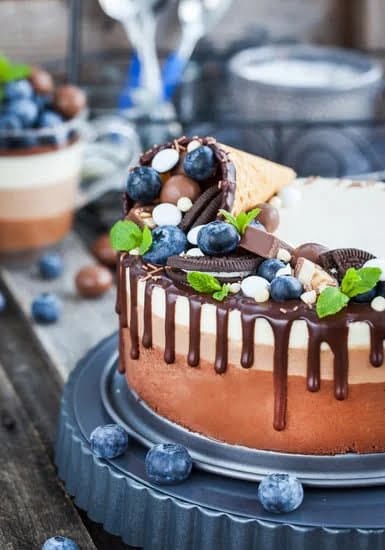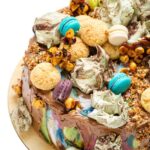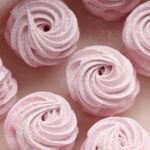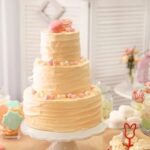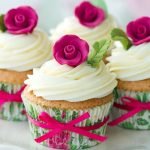Buttercream is an essential component in cake decoration, and mastering the art of making it from scratch can elevate your cake decorating skills to new heights. In this blog post, we will explore the importance of buttercream in creating stunning cakes, its benefits and versatility, and provide step-by-step instructions on how to make it from scratch.
Whether you’re a beginner or an experienced decorator, understanding the basics of buttercream will enhance your ability to create beautiful and delicious cakes.
Buttercream has long been favored by cake decorators for its smooth texture, creamy taste, and ability to hold intricate designs. Its versatility allows for various decorating techniques, making it suitable for any occasion or theme. From simple borders to intricate floral patterns, buttercream can be easily piped onto cakes to create stunning designs. By learning how to make buttercream from scratch, you’ll have full control over the flavor and consistency of your frosting, giving your cakes a professional touch.
In this blog post, we will not only guide you through the process of making buttercream but also introduce you to different types of buttercream commonly used in cake decoration. We will discuss the essential ingredients needed for homemade buttercream as well as provide tips on customizing flavors and adding vibrant colors.
Additionally, we’ll explore various piping and decorating techniques that can transform any plain cake into a masterpiece. Finally, we’ll address common issues faced when making buttercream and share expert advice on troubleshooting and storage.
So whether you’re a baking enthusiast looking to improve your cake decorating skills or someone preparing for a special celebration, join us on this journey as we delve into the world of buttercream and learn how to create beautiful works of art with just a few simple ingredients.
Types of Buttercream
When it comes to cake decoration, buttercream is the frosting of choice for many cake decorators. Its smooth and creamy texture, along with its ability to hold intricate designs, makes it a popular option for creating beautiful cakes. There are several different types of buttercream that can be used in cake decorating, each with its own unique characteristics and best uses.
American Buttercream
American buttercream is the most basic type of buttercream and is made with a simple combination of butter, powdered sugar, milk or cream, and flavorings. It has a rich and sweet taste and a slightly grainy texture. American buttercream is easy to make and is best suited for spreading onto cakes, creating borders and decorations, or adding as a filling between cake layers.
Swiss Meringue Buttercream
Swiss meringue buttercream is made by whipping egg whites and sugar over a double boiler until they reach a high temperature. Then, softened butter is gradually added until the mixture becomes smooth and creamy. This type of buttercream has a light and silky texture and a less sweet taste compared to American buttercream. Swiss meringue buttercream is great for frosting cakes evenly and smoothly and can also be used for piping delicate decorations.
Italian Meringue Buttercream
Italian meringue buttercream is similar to Swiss meringue buttercream in terms of ingredients but involves cooking sugar syrup instead of combining egg whites with sugar directly. The hot sugar syrup is poured into whipped egg whites to form a stable meringue, which then has softened butter incorporated into it until it becomes velvety smooth.
Italian meringue buttercream has an incredibly smooth texture and pairs well with more complex flavors like citrus or fruit purees. This type of buttercream is often used for filling cakes, frosting cupcakes, or creating intricate piping designs.
Understanding the different types of buttercream available allows cake decorators to choose the best option based on their desired taste, texture, and decorative needs. Experimenting with these various types of buttercream can add depth and creativity to cake decorating projects.
Essential Ingredients for Homemade Buttercream
To create homemade buttercream, it is important to have the right ingredients. Here is a detailed list of essential ingredients needed to make a delicious and smooth buttercream for cake decoration:
- Butter: The main component of buttercream, unsalted butter should be used for optimal control over the amount of salt in the recipe. It is recommended to use high-quality, European-style butter for a rich flavor.
- Powdered Sugar: Also known as confectioner’s sugar or icing sugar, powdered sugar provides sweetness and helps to achieve a smooth texture in the buttercream. Sift the powdered sugar before using it to ensure there are no lumps.
- Vanilla Extract: Vanilla extract adds a delightful flavor to buttercream. Choose pure vanilla extract for the best results.
- Milk or Heavy Cream: A small amount of milk or heavy cream is added to adjust the consistency of the buttercream and make it more spreadable.
Optional Ingredients for Flavor Variation:
- Cocoa Powder: For a chocolate variation, sift in unsweetened cocoa powder along with the powdered sugar.
- Fruit Puree or Extracts: Add your favorite fruit puree, such as strawberry or raspberry, or extracts like lemon or almond, to infuse different flavors into your buttercream.
- Coffee or Liqueurs: Adding instant coffee granules, espresso powder, or your preferred liqueur can give your buttercream a unique and delicious twist.
It’s important to note that quantities may vary depending on your desired batch size and personal taste preferences. Start with smaller amounts of additional flavors and add gradually until you achieve your desired taste.
Remember that using fresh and high-quality ingredients will greatly enhance the flavor and texture of your homemade buttercream. So always aim for the best quality ingredients available.
Step-by-Step Guide
Making buttercream from scratch may seem intimidating, but with the right technique and ingredients, it can be a simple and rewarding process. Follow this step-by-step guide to master the art of making buttercream for your cake decoration needs.
1. Gather Your Ingredients:
To make homemade buttercream, you will need:
- 1 cup (2 sticks) unsalted butter, at room temperature.
- 4 cups powdered sugar (also known as confectioners’ sugar).
- 2 teaspoons pure vanilla extract.
- Pinch of salt.
– Optional: 1-2 tablespoons milk or heavy cream to adjust consistency 2. Cream the Butter:
In a large mixing bowl, cream the softened butter until smooth using an electric mixer or stand mixer fitted with a paddle attachment. Be sure to scrape down the sides of the bowl to incorporate all the butter.
3. Gradually Add Sugar:
Add powdered sugar gradually, about one cup at a time, while continuing to mix on low speed. This will prevent the mixture from becoming too dusty. Mix until well combined and fluffy.
4. Incorporate Vanilla Extract and Salt:
Pour in the vanilla extract and add a pinch of salt for balanced flavor. Continue mixing until fully incorporated.
5. Adjust Consistency (Optional):
If your buttercream is too stiff or thick, you can add milk or heavy cream one tablespoon at a time until you reach your desired consistency. If it’s too thin or runny, add more powdered sugar gradually until it thickens up.
6. Beat Until Smooth:
Turn up the mixer speed to medium-high and beat for about 3-4 minutes until the buttercream becomes light, creamy, and smooth in texture. This will ensure that all ingredients are fully combined.
7. Your Homemade Buttercream Is Ready.
Congratulations. You have successfully made homemade buttercream. It is now ready to be used for cake decoration. If you are not using the buttercream immediately, cover it with plastic wrap or transfer it to an airtight container and refrigerate until needed.
By following this step-by-step guide, you can achieve a delicious and versatile buttercream that will elevate your cake decoration skills. Feel free to experiment with different flavors, such as substituting vanilla extract with other extracts like almond or peppermint, or adding citrus zest for a refreshing twist. With practice, you will become confident in your ability to create beautiful and tasty buttercream masterpieces.
Customizing Your Buttercream
One of the great advantages of using buttercream in cake decoration is its ability to be customized with various flavors and colors. By adding unique flavors and vibrant colors to your buttercream, you can elevate the taste and visual appeal of your cakes. In this section, we will explore different ways to add flavor and color to your buttercream for cake decoration.
Adding Flavor to Buttercream
There are numerous options available for adding flavor to your buttercream. One simple method is to use extracts such as vanilla, almond, or lemon. These extracts can be added in small amounts and gradually increased until the desired flavor is achieved.
Another option is to incorporate zest from citrus fruits into your buttercream for a fresh and tangy taste. For those who enjoy more unique flavors, spices like cinnamon, nutmeg, or cardamom can be added to create interesting flavor profiles. The key when adding flavorings is to start with a minimal amount and adjust according to personal preference.
Coloring Your Buttercream
Adding color to your buttercream opens up endless possibilities for cake decoration. Gel food coloring is recommended over liquid forms as it won’t change the consistency of the frosting. Start by adding a small amount of gel food coloring, mix well, and gradually increase until the desired shade is achieved.
To achieve precise colors, it may be helpful to have a color chart or guide on hand that shows how mixing different colors can produce specific shades. Remember that certain colors like red or black may require more food coloring than others and might alter the taste slightly.
Blending Techniques for Flavors and Colors
When incorporating flavors or colors into buttercream, it’s important not to overmix as this could lead to changes in texture or consistency. For both flavorings and colorings, it’s best to add them towards the end of making the buttercream and gently fold or mix until well combined.
If you are making a large batch of buttercream and need to split it into different colors, divide the buttercream evenly and add the colorings in separate bowls. This way, you can control the intensity of each color individually without affecting the overall consistency of the buttercream.
By customizing your buttercream with unique flavors and vibrant colors, you can take your cake decoration to the next level. Whether you prefer classic flavors like vanilla or chocolate, or more adventurous options like citrus zest or exotic spices, there are endless possibilities for creating a truly personalized cake.
Additionally, by understanding proper blending techniques and utilizing gel food coloring, you can achieve precise and vibrant colors without compromising the texture of your buttercream. In the next section, we will explore different piping and decorating techniques using your customized buttercream to transform cakes into stunning works of art.
Piping and Decorating Techniques
One of the most exciting aspects of cake decoration is the opportunity to unleash your creativity and transform a plain cake into a stunning work of art. Piping and decorating techniques play a crucial role in achieving this transformation, allowing you to bring your vision to life using buttercream. In this section, we will explore the different piping tips and techniques that can help you take your cake decoration skills to the next level.
To begin, it is essential to familiarize yourself with different piping tips. There are various types available, each producing unique designs and effects. Some popular options include round tips for creating dots or outlines, star tips for adding textures or rosettes, leaf tips for realistic foliage, and petal tips for intricate floral designs. By experimenting with different tips, you can create visually striking patterns and decorations that elevate the appearance of your cake.
Once you have chosen your desired piping tip, it’s time to learn the techniques necessary to achieve specific designs. For example, if you want to make roses on your cake, start by holding the piping bag perpendicular to the surface of the cake.
Apply pressure evenly while moving in a circular motion from the center outward to create layers resembling petals. Similarly, borders can be achieved by applying consistent pressure while moving in a continuous motion around the edge of the cake.
Beyond basic techniques like roses and borders, there are countless other designs you can create using buttercream. Ruffles can add an elegant touch by creating cascading waves on your cake’s sides or layers. Basketweave patterns can mimic intricate woven baskets that give off a rustic charm. With practice and experimentation, you can discover new ways to use buttercream as an artistic medium.
Remember that patience and practice are vital when mastering these techniques. It may seem challenging initially, but with time and perseverance, you will develop confidence in your ability to create beautiful decorations with buttercream. Don’t be afraid to seek inspiration from cake decorating books, online tutorials, or even professional cake decorators.
Troubleshooting Common Buttercream Issues
Buttercream is a versatile and delicious frosting that can elevate the appearance and taste of any cake. However, even experienced bakers may encounter issues when making buttercream from scratch. In this section, we will address some common problems faced when making buttercream and provide troubleshooting tips and solutions to help you achieve a smooth and perfect finish on your cakes.
One common issue with buttercream is graininess. Grainy buttercream can result from using ingredients that are too cold or insufficiently mixing the ingredients together. To fix this problem, ensure that all ingredients are at room temperature before you start making the buttercream.
Additionally, make sure to mix the butter and sugar thoroughly until they are well incorporated. If your buttercream still appears grainy, you can try placing it in a heatproof bowl over simmering water and gently whisking until it becomes smooth.
Another issue that may arise is curdling, which happens when the butter separates from the other ingredients during mixing. This can be due to adding the ingredients too quickly or using ingredients that are at different temperatures.
To prevent curdling, ensure that all ingredients are at room temperature before starting and add them gradually while mixing on low speed. If your buttercream still curdles, try placing it in the refrigerator for about 20 minutes to firm up, then whip it again until smooth.
Melting is another common problem when working with buttercream, particularly in warmer climates or if your kitchen is hot. Melting can cause your beautifully piped designs to lose their shape and collapse. To combat melting, make sure to keep your workspace cool by turning on air conditioning or fans if necessary. You can also add a small amount of shortening to your buttercream recipe to help stabilize its structure.
By following these troubleshooting tips and solutions, you can overcome common issues that may arise when making buttercream from scratch. Remember that practice makes perfect, and as you become more experienced, you will be able to troubleshoot and fix any buttercream mishaps that come your way. With a bit of patience and perseverance, you will achieve smooth, delicious, and stunning buttercream creations.
| Problem | Solution |
|---|---|
| Graininess | Ensure ingredients are at room temperature and mix thoroughly. If still grainy, gently whisk over simmering water. |
| Curdling | Add ingredients gradually while mixing on low speed. If curdling occurs, refrigerate briefly, then whip again. |
| Melting | Keep workspace cool and consider adding a small amount of shortening to stabilize the structure. |
Storage and Handling
One of the essential aspects of cake decoration is the proper storage and handling of the buttercream masterpiece. After putting in all the hard work to create a stunning design, it’s important to ensure that the buttercream retains its freshness, texture, and structure. In this section, we will discuss the steps to preserve your beautiful creation.
Refrigeration and Freezing
To maintain the quality of your buttercream cake, it is recommended to refrigerate it if you do not plan to serve it immediately. The low temperature helps in preserving the freshness and preventing any spoilage. However, before refrigerating, make sure that the cake has completely set and any decorations, like flowers or fondant accents, have hardened.
When refrigerating a buttercream cake, it’s crucial to protect it from absorbing any odors from other foods in the refrigerator. You can do this by placing it inside an airtight container or covering it tightly with plastic wrap. Avoid storing the cake near strong-smelling items like onions or garlic.
If you need to store a buttercream cake for an extended period, freezing is an option. To freeze a fully decorated buttercream cake, first place it uncovered in the freezer until the surface hardens slightly. Then wrap it tightly with plastic wrap or place it in a freezer bag to prevent freezer burn. Make sure you label and date your cake to keep track of its shelf life.
Handling and Storage Duration
When handling a buttercream masterpiece, be mindful of avoiding direct contact with your hands as much as possible to prevent smudging or damaging the design. Instead, use clean spatulas or palette knives for lifting and transferring cakes.
The duration for which you can safely store a buttercream-decorated cake depends on various factors such as climate conditions and ingredients used. Generally speaking, a buttercream-covered cake can be stored at room temperature for 2-3 days. However, if your cake incorporates perishable fillings such as fresh fruit or dairy-based whipped cream, it’s best to store it in the refrigerator instead.
When it comes to transportation and storing the cake after decorating, stability is key. To prevent any damage to the design or structure, consider using a cake carrier with locking mechanisms to secure the cake during transportation. If possible, place the cake on a non-slip mat inside the carrier for added stability.
Proper handling and storage of your buttercream masterpiece will ensure that all your hard work pays off and that your cake looks and tastes its best when served.
Conclusion
In conclusion, homemade buttercream is an essential tool for elevating your cake decorating skills. Throughout this blog post, we have explored the importance of buttercream in cake decoration and discussed the various types of buttercream available. We have also provided a detailed guide on making buttercream from scratch, along with tips and tricks to achieve the perfect consistency.
By making your own buttercream, you have control over the quality and flavor of your frosting. Using high-quality ingredients ensures a superior taste and texture in your buttercream. Additionally, you can experiment with different flavors such as chocolate, strawberry, or citrus to add a unique touch to your cakes.
Furthermore, mastering the art of making buttercream opens up endless possibilities for customization and creativity in cake decorating. You can easily add flavorings and colorings to suit your preferences and create vibrant designs on your cakes. With various piping techniques at your disposal, you can transform simple cakes into stunning masterpieces.
Frequently Asked Questions
What is the best buttercream to decorate a cake?
The best buttercream to decorate a cake ultimately depends on personal preference and the desired outcome of the cake decoration. However, Swiss meringue buttercream is often regarded as one of the best options for decorating cakes. This type of buttercream is made by gently heating egg whites and sugar, then whipping them to create a light, fluffy meringue.
Softened unsalted butter is gradually added to this meringue base, resulting in a smooth and creamy frosting that holds its shape well when piped onto a cake. Swiss meringue buttercream has a less sweet taste compared to American buttercream, making it versatile for various flavor combinations.
How do you decorate a cake with buttercream for beginners?
Decorating a cake with buttercream as a beginner can be an enjoyable and rewarding experience. Start by preparing your cake with a crumb coat, which involves applying a thin layer of buttercream all over the cake to seal in any crumbs. This step helps create a smooth surface for further decorating.
Next, choose piping tips that suit the design you have in mind – popular options include star tips or round tips for creating borders and rosettes. Begin by piping basic borders around the top and bottom edges of the cake before moving on to more intricate designs like rosettes or flowers. Practice basic techniques like writing on cakes using different tip sizes or experimenting with colors through food coloring gel incorporation.
What kind of frosting is best for decorating cakes?
When it comes to frosting that is best for decorating cakes, many experienced bakers prefer using Swiss meringue buttercream or Italian meringue buttercream due to their stability and smooth texture. Both types start with whipped egg whites and sugar syrup but differ slightly in preparation method – Swiss using the heated sugar syrup while Italian combining hot syrup directly into whipped egg whites.
These frostings provide excellent coverage on cakes while lending themselves well to detailed designs created through piping techniques and fondant work if desired since they hold their shape without melting easily at room temperature like other frostings. Swiss and Italian meringue buttercreams also have a less sweet taste compared to standard American buttercream, allowing the flavors of the cake and other fillings to shine through in harmony.

Welcome to our cake decorating blog! My name is Destiny Flores, and I am the proud owner of a cake decorating business named Cake Karma. Our mission is to provide delicious, beautiful cakes for all occasions. We specialize in creating custom cakes that are tailored specifically to each customer’s individual needs and tastes.

